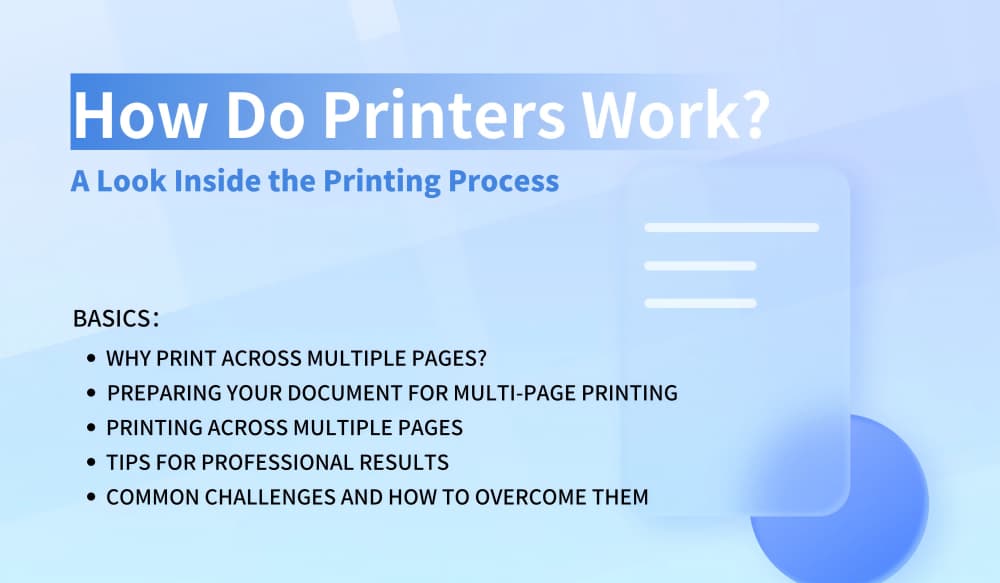How Do Printers Work? A Look Inside the Printing Process.

Printers have become a must-have in the home and office, making it easy to produce everything from documents to high-quality photos at the push of a button. But have you ever stopped to wonder how a printer actually works? Understanding the basic mechanics and technology behind your printer can help you use your device better and even solve problems more efficiently. In this blog post, we’ll take a closer look at how printers work, covering the most common types: inkjet and laser printers.
Inkjet Printers: Precision With Tiny Droplets
Inkjet printers are one of the most common types used in homes and small offices. They are known for their ability to produce high quality colour images and text. But how do they achieve this?
How Inkjet printing Works: At the heart of an inkjet printer are tiny nozzles, also known as printheads, which spray tiny droplets of ink onto the paper. These droplets are so small that they are measured in picolitres (trillionths of a litre). The print head moves back and forth across the paper, depositing ink in precise patterns to create text and images.
Ink Cartridges: Inkjet printers use cartridges containing liquid ink, usually cyan, magenta, yellow and black (CMYK). By combining these basic colours in different proportions, the printer can produce a wide range of colours. Some printers may have additional cartridges for photo printing to improve colour accuracy and depth.
Thermal VS. Piezo: Inkjet printers typically use one of two technologies to propel ink droplets. Thermal inkjet printers heat the ink to create bubbles, which then burst and push the droplets onto the paper. On the other hand, piezoelectric inkjet printers use vibrations from piezoelectric crystals to eject the droplets. Both methods are effective, but they work slightly differently to achieve the same results.
Laser Printers: Speed and Efficiency with Laser Precision
Laser printers are another popular choice, especially in office environments where speed and efficiency are critical. These printers are known for their ability to produce crisp text and graphics quickly.
How Laser Printing Works: The process begins with the use of a laser beam to project a page image onto a rotating drum coated with a light-sensitive material. The area of the drum that is hit by the laser is electrically charged. As the photoconductive drum rotates, it passes through a toner cartridge containing fine powder. The toner particles adhere to the charged area of the photoconductive drum, forming an image or text.
Toner and Fixation: Once the toner reaches the drum, it is transferred to a sheet of paper. The paper is then passed through heated rollers (called fixers) that melt the toner onto the paper, bonding it permanently to the surface. This process allows laser printers to print at high speeds, making them ideal for high-volume print jobs.
Monochrome and Colour Laser Printers: Monochrome laser printers use only black toner, making them a cost-effective choice for printing documents. Colour laser printers use multiple toner cartridges (typically cyan, magenta, yellow and black) to produce full colour prints. Although colour laser printers are more expensive than monochrome printers, they offer the extra flexibility of colour printing without sacrificing speed.
Comparing Inkjet and Laser Printers
Print Quality: Inkjet printers are generally better suited to high quality photo prints because of their ability to blend colours smoothly. Laser printers, while capable of printing crisp text and graphics, may not achieve the same level of colour detail in photographs as inkjet printers.
Speed: Laser printers are faster than inkjet printers, especially when printing large amounts of text. This makes them a popular choice for office environments where efficiency is critical.
Cost: While inkjet printers typically have lower upfront costs, the cost of replacing ink cartridges can add up, especially for heavy users. Laser printers have more durable toner cartridges, and the cost per page may be lower over time.
Maintenance: Both types of printers require regular maintenance to ensure optimal performance. Inkjet printers require regular use to prevent the ink from drying out and clogging the nozzles. On the other hand, laser printers require regular replacement of toner cartridges and other components such as drums.
Conclusion
Understanding how printers work can help you make more informed decisions when choosing a printer, maintaining it, or solving common problems. Whether you choose an inkjet printer for high-quality photo printing or a laser printer for fast, efficient document printing, understanding the inner workings of these devices can help you get the most from your investment.
With the right printer and a little knowledge of its operation, you can tackle any printing task with confidence.

Every effort has been made to ensure the accuracy of the article, but it is still for informational purposes only and may contain errors or inaccuracies. It is a general resource for understanding commonly used concepts. For accurate information or assistance with our products, we recommend visiting our website, where our team is ready to answer any questions or concerns you may have.
Search the Blog
CONTACT US AT ANY TIME
If you have any questions, suggestions or are interested in working with us, please feel free to contact us !
MooTooM-WuTeng is a domestic design, R & D, production, sales as one, and has a wide-format digital printing, UV printing, digital printing and related supplies, the core intellectual property rights of manufacturers.





1.jpg)

